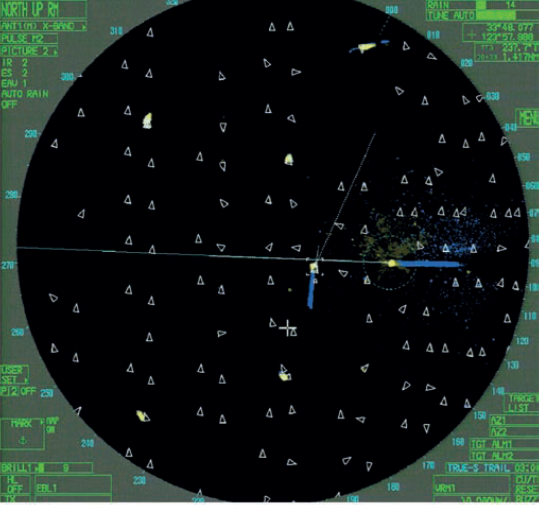202452 Extreme traffic density requires extra measures
As edited from BMA (Bahamas) report issued 11 September 2020 Cathinka Spirit v Zhe Ling Yu Yun 60007
In good visibility and in darkness, a chemical tanker was underway at about 13 knots with an OOW and a lookout on the bridge. For several hours, they had been navigating in waters heavily congested with fishing boats, during which time the Master was also on the bridge to make decisions where necessary. At times there were over 100 AIS targets registered on the radar’s 3-mile scale, a mixture of moving and stationary targets. By 23:00, they had cleared the dense fishing fleet, so the Master left the bridge.
At 23:19 the lookout reported what he believed to be a fishing vessel ahead and the OOW acquired it as an ARPA target on the X-band radar soon after.
The Master of the other vessel later reported he sighted the tanker at around 23:30. As it transpired, this vessel was not a fishing vessel but a fish transportation vessel (FTV) underway and en route to port to discharge a cargo of fish loaded at the fishing grounds.
Approximately three minutes before CPA, which was essentially zero, the chemical tanker bridge team attempted to attract the attention of the other vessel using an Aldis lamp. The two vessels, on a steady bearing and closing range, maintained their course and speed until they were less than 0.5NM apart.
At this point, even though the FTV was the give way vessel, the chemical tanker’s OOW took control of manual steering and altered course to port using 15 degrees port helm. At about the same time, the FTV made a bold alteration of course to starboard. Neither vessel used sound signals prior to their alteration but the tanker sounded two short blasts when it became apparent that the FTV was also taking action.
The vessels nonetheless collided with a closing speed of approximately 15 knots. The tanker’s bow struck the FTV on the port side at an angle of 45 degrees. The tanker’s Master and Chief Officer arrived quickly on the bridge and the engines were stopped, deck lights illuminated and an announcement made on the public address. The tanker’s crew prepared lifesaving equipment, boarding arrangements and launched the rescue boat to help recover the crew of the stricken FTV who were in the process of abandoning ship.
Twelve of the FTV’s crew were recovered from a liferaft by the tanker. The remaining five crew could not launch the FTV’s second liferaft and were recovered by a nearby fishing vessel. The damaged FTV sank approximately an hour after the collision.
The investigation found, among other things, that there were no navigational constraints that prevented the tanker from reducing speed or altering course to starboard in ample time. Also, whilst the tanker attempted to attract the attention of the FTV with an Aldis lamp, no use was made of suitable sound signals until five seconds before the collision, when the tanker sounded two short blasts.
The report revealed that there have been many similar incidents in the same region, with significant loss of life. A study covering the years 2006-2011 identified 268 incidents involving fishing vessels in the proximate waters, resulting in 562 deaths. Common navigational issues in these cases are a failure to adjust passage plans to avoid areas of high density fishing traffic, failure to reduce speed in high density traffic areas and action to avoid collision being inappropriate, taken too late, with too small a margin for error or a combination of the three.

Taker’s radar at 21.33
Lessons learned
-
Passage plans should, to the extent possible, be adjusted to avoid well known highly congested fishing grounds.
-
It is good practice to reduce speed when in highly congested waters.
- Trying to attract the attention of another vessel? Rule 34(d) is clear. When vessels in sight of one another fail to understand the intentions or actions of the other, or if one vessel is in doubt whether sufficient action is being taken by the other to avoid collision, the vessel in doubt shall immediately show such doubt by giving at least five short rapid blasts on the ships whistle.
